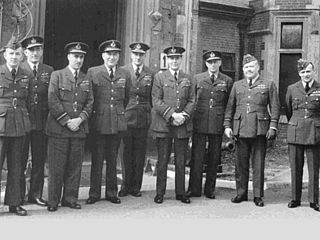Related Research Articles

Captain George Edward Henry McElroy MC & Two Bars, DFC & Bar was a leading Irish fighter pilot of the Royal Flying Corps and Royal Air Force during World War I. He was credited with 47 aerial victories.
Captain William Melville Alexander was a Canadian First World War flying ace, officially credited with 22 aerial victories.
John Inglis Gilmour, was a British flying ace of the First World War. He was the highest scoring Scotsman in the Royal Flying Corps, with 39 victories.
Leonard Henry Rochford, was a British flying ace of the First World War, credited with 29 aerial victories. He returned to military service in the Royal Air Force during the Second World War.

Air Marshal Sir Brian Edmund Baker, was an officer of the Royal Air Force who served in both World Wars. He was a flying ace in World War I credited, in conjunction with his gunners, with twelve victories, comprising one enemy aircraft captured, four destroyed, and seven "out of control".
Flight Lieutenant James Anderson Slater was a British First World War flying ace, credited with 24 aerial victories. He served in the Royal Air Force (RAF) as an instructor after the war until killed in a flying accident.
Captain William Otway Boger was a Canadian World War I flying ace credited with five aerial victories.
Captain Reginald Morse Charley was a British World War I flying ace credited with six aerial victories.
Richard Raymond-Barker, MC was a British aviator and flying ace, credited with six aerial victories in the First World War. He was Manfred von Richthofen's penultimate victim.
Douglas Alfred Savage, (1892–1967) was a British flying ace of the First World War, credited with seven aerial victories.
Captain Reginald Howard Rusby Distinguished Flying Cross|DFC was a World War I flying ace credited with ten aerial victories.
Captain James Dennis Payne was a World War I flying ace credited with fourteen aerial victories.
Group Captain Frederick Sowrey, was a British aviator, military officer, and a flying ace of the First World War credited with thirteen aerial victories. He was most noted for his first victory, when he shot down Zeppelin L32 during its bombing raid on England. Having risen rapidly in rank during the war, he remained in service until 1940.
Squadron Leader Edwin Stuart Travis Cole was a British World War I flying ace credited with eight aerial victories. He returned to military service in 1939 for the Second World War.
Captain Maxwell Hutcheon Findlay was a Scottish World War I flying ace credited with 14 aerial victories. He remained in the RAF postwar for several years before going on to a civilian aviation career that ended with his death in the Johannesburg Air Race of 1936.
Captain Thomas Laurence Purdom was a Scottish World War I flying ace credited with 13 confirmed aerial victories.
Flight Commander Guy William Price was an Irish Royal Naval Air Service flying ace during World War I, having 12 confirmed aerial victories. He was awarded the Distinguished Service Cross twice within a 22-day period.
Captain William Ernest Reed, was an English World War I flying ace credited with nine aerial victories. He continued in military service until 1938.
Captain Ronald Roscoe Thornely was an English World War I flying ace. He was credited with nine aerial victories while flying for the Royal Naval Air Service.
James Martin Child was a World War I flying ace. A British citizen living in Canada when the war began, he returned home for service. After being assigned to the Royal Flying Corps, he was credited with eight aerial victories. He died while rescuing a fellow pilot from a crashed aircraft.
References
- 1 2 3 4 "Thomas Sydney Sharpe". The Aerodrome. 2016.
- ↑ "No. 29133". The London Gazette. 16 April 1915. p. 3729.
- ↑ "No. 29517". The London Gazette (Supplement). 21 March 1916. p. 3156.
- ↑ "No. 29575". The London Gazette (Supplement). 9 May 1916. p. 4646.
- 1 2 3 Shores, Franks & Guest (1990), p. 336.
- ↑ "No. 29958". The London Gazette. 23 February 1917. p. 1881.
- ↑ "No. 30553". The London Gazette (Supplement). 1 March 1918. p. 2706.
- ↑ "No. 30913". The London Gazette (Supplement). 20 September 1918. p. 11254.
- ↑ "No. 31271". The London Gazette. 4 April 1919. p. 4421.
- ↑ "No. 31887". The London Gazette (Supplement). 4 May 1920. p. 5194.